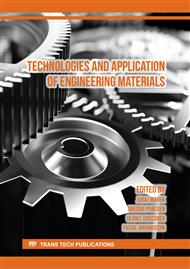[1]
L. Karlinasari, D. Hermawan, A. Maddu, B. Martianto, I.K. Lucky, N. Nugroho, Y.S. Hadi, Acoustical properties of particleboards made from betung bamboo (Dendrocalamus asper) as building construction material, BioResources. 7 (2012) 5700–5709.
DOI: 10.15376/biores.7.4.5700-5709
Google Scholar
[2]
A. Putra, F.A. Khair, M.J.M. Nor, Utilizing Hollow-Structured Bamboo as Natural Sound Absorber, Archives of Acoustics. 40 (2015) 601–608.
DOI: 10.1515/aoa-2015-0060
Google Scholar
[3]
S. Chen, Y. Jiang, The acoustic property study of polyurethane foam with addition of bamboo leaves particles, Polymer Composites. 39 (2018) 1370–1381.
DOI: 10.1002/pc.24078
Google Scholar
[4]
T. Koizumi, N. Tsujiuchi, K. Fujita, Performance improvement of sound-absorbing materials using natural bamboo fibers and their application, WIT Press, 2004.
Google Scholar
[5]
E. I Gusti Lanang Bagus, Bamboo Structure and Engineering, 1st ed., National Education University, Denpasar Bali, 2017.
Google Scholar
[6]
L. W., Anatomy and properties of bamboo., GTZ Publication. (1986) 196–207.
Google Scholar
[7]
F.A. Khair, P. Azma, J.M. Mohd Nor, N. Atiqah, M.Z. Selamat, Preliminary study on bamboo as sound absorber, Applied Mechanics and Materials. 554 (2014) 76–80.
DOI: 10.4028/www.scientific.net/amm.554.76
Google Scholar
[8]
S.H. Lee, S. Wang, Biodegradable polymers/bamboo fiber biocomposite with bio-based coupling agent, Composites Part A: Applied Science and Manufacturing. 37 (2006) 80–91.
DOI: 10.1016/j.compositesa.2005.04.015
Google Scholar
[9]
I.B.K. Arinasa, I.. N. Peneng, Types of Bamboo in Bali and Its Potential., 1st ed., LIPI Press, 2013.
Google Scholar
[10]
A. Kusno, K. Sakagami, T. Okuzono, M. Toyoda, T. Otsuru, R. Mulyadi, K. Kamil, A pilot study on the sound absorption characteristics of chicken feathers as an alternative sustainable acoustical material, Sustainability (Switzerland). 11 (2019) 1–11.
DOI: 10.3390/su11051476
Google Scholar
[11]
A. Kusno, M.T. Ishak, R. Rahim, B. Hamzah, R. Mulyadi, N. Jamala, R. Anggraeni, Coconut Leaf Midribs as an Acoustical Panel-Feasibility Study through Impedance Tube Method, in: IOP Conf. Ser. Mater. Sci. Eng., 2020: p.1–9.
DOI: 10.1088/1757-899x/875/1/012007
Google Scholar
[12]
I. Ismail, Preservative properties of seawater in ampelous bamboo using the Boucherie-Morisco method, Gadjah Mada University, 2009.
Google Scholar
[13]
Team Elsspat, Preservation of Wood and Bamboo, 1st ed., Dinamika Media, Jakarta, 2007.
Google Scholar
[14]
J. Niresh, S. Neelakrishna, S. Subharan, R. Prabhakaran, Performance Testing for Sound Absorption Coefficient by Using Impedance Tube, Research Journal of Applied Sciences, Engineering and Technology. 11 (2015) 185–189.
DOI: 10.19026/rjaset.11.1706
Google Scholar
[15]
I. Standard, ISO 10534-2:1998 Acoustics — Determination of sound absorption coefficient and impedance in impedance tubes — Part 2: Transfer-function method, (1998).
DOI: 10.3403/02552411u
Google Scholar
[16]
S. Hasniati Hasan, S. Zelviani, Testing of Density and Water Content as on Acoustic Boards Made from Pandanus Tectorius Leaves, Jft. 6 (2019) 113–120.
Google Scholar



